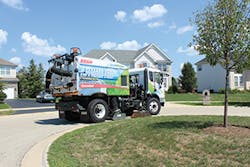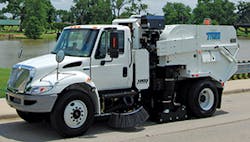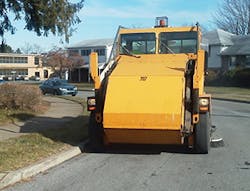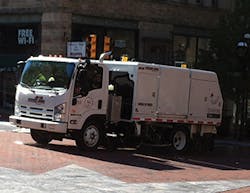Keeping a city’s streets, storm sewers, and catch basins clean is an essential service for its residents, even though they might not pay much attention to the work as it occurs. Cleaner air and water are the result—proven by numerous studies—and that’s important to every person within a community.
San Diego, CA, has 75,000 storm drains and 889 miles of drainage pipe to keep clean. Concrete and dirt storm drain channels total 84 miles, surrounded by more than 100 miles of fencing (to keep people and debris out).
In San Diego, a crew of 16 works hard to keep the city’s 2,700 miles of improved streets clean. That many miles of streets add up to a lot of sweeping.
“We’re averaging about 100,000 miles swept in a year,” says Thomas Abeyta III, public works supervisor for the San Diego Storm Water Department. That sweeping keeps 220,000 pounds of debris out of the storm drains.
The city’s street sweeping crewmembers drive a fleet of 17 sweepers, including five regenerative-air type and one vacuum sweeper. The rest are the mechanical type. None of the sweepers operates on alternative fuels.
“We had a managed competition three years ago and minimized our fleet, to cut costs,” says Abeyta. “We’ll add some sweepers back.”
Abeyta prefers to keep “a diverse fleet,” with sweepers from different manufacturers. “We’ve done some studies on which ones are most effective for our terrain,” he explains (“Street Sweeping Pilot Studies,” January/February 2013, Stormwater).
However, the San Diego crews rely on regenerative air sweepers from Tymco. Their chosen Tymco model is the 500x. Abeyta likes the Tymco 500x sweepers “for their stormwater quality aspects. They keep everything inside the hopper and they have separators. We find they’re more effective in capturing fine particles.”
He adds, “From a maintenance standpoint, there are fewer moving parts so the cost to maintain and repair them is less.”
The Tymco 500x combines advanced electronics and the industry’s highest dumping hopper lift assembly—a whopping 11 feet. This sweeper’s fast dump cycle is less than 68 seconds.
San Diego’s street sweeping crews operate on two shifts. The daytime crews sweep residential areas, either once a month or once every other month depending on whether the areas are categorized as high- or low-maintenance need. The night crews clean streets in the commercial districts and highly traveled roads. These areas are swept once a week.
The crews pay particular attention to streets in sensitive water-quality areas such as La Jolla, Chollas Creek, and Los Pinasquitos. If necessary, they sweep these areas more frequently.
Regular street sweeping and catch basin cleaning schedules are suspended before, during, and after heavy rainstorms. At these times the employees in the various divisions of the Public Works Department operate under “storm patrol mode.”
“They’re all assigned to certain areas of the city. They check to be sure that critical drains are working to prevent flooding, clean right of ways, and remove tree debris or mud,” says Abeyta.
Tymco Model 600 regenerative-air sweeper
One might think that in a city that doesn’t have to deal with long snow or rain seasons, keeping the streets swept would be relatively easy. But every city has its own challenges when it comes to street sweeping.
“Parked cars,” says Abeyta. “People don’t understand the impact of street sweeping. Some areas are so densely populated that they don’t have off-street parking, so we balance between posting areas for sweeping [temporarily no parking allowed] and keeping these people happy.”
As is the case in most cities and regions, vegetation makes extra work for San Diego’s street sweeping crews. The organic debris varies by season.
“In the fall, we have a lot of leaves from trees in certain areas. In the summer, pine needles are one of our problems,” he says.
The heavier winds associated with storms, such as the hot Santa Ana winds, strew small branches and eucalyptus pods all over the streets. And in beach areas of San Diego, palm fronds fall off of palm trees, littering the streets.
“We operate on a five-year contract, and our budget increases every year,” explains Abeyta. “We’re in year three now, and the budget for street sweeping is $3 million for the year.”
San Diego has done some studies on how street sweeping influences the amount of pollution in stormwater runoff and continues to do so.
“We’re in our fifth study now,” says Abeyta. “They tested for a whole year during dry weather the material we picked up, and they monitored storm drains. They tested storm drains both before and after we swept.”
Kings Mountain, NC
The city of Kings Mountain, NC, has a strong connection to American history. It is named for the American Revolutionary War battle that was fought a mere 5 miles away—just over the present South Carolina state line—in October 1780.
Thomas Jefferson himself decreed the Battle of Kings Mountain to be the turning point in the American colonists’ favor. The victory by frontier militiamen over the disciplined, trained British army dispelled the notion that British Loyalists in the south would join the Redcoats to defeat the colonists.
Today, Kings Mountain covers almost 12.6 square miles. Located 30 miles west of Charlotte, the city has a population of about 12,000.
Kings Mountain has 52 miles of commercial and residential streets that have to be swept.
Approximately 500 catch basins need regular cleaning, too.
For cleaning and vacuuming the storm sewers and catch basins, the stormwater department relies on two F Series Jet/Vac trucks (combination cleaning and vacuum) made by the Aquatech division of Hi-Vac Corporation.
Rickey Putnam, stormwater administrator for Kings Mountain, says that the department has been very pleased with the F Series trucks. “It really saves a lot of manual labor. You can vacuum or shoot water at high pressure. If we find sediment, we vacuum it out then use the high pressure to clean it.”
He notes that all catch basins are on a yearly cleaning schedule, but flood-prone areas comprise “a good 40%” of the city, he adds. Catch basins in these areas are checked at least once a week, and crews clean out any sediment that has accumulated.
Kings Mountain is in the foothills of the mountains, with lots of trees. The city picks up leaves from October through the middle of February. The leaves cause lots of work for the street crews.
“People put leaves in the street, not on the curb as they’re supposed to,” laments Putnam. Rain sends the leaves on to the catch basins, where they cause clogs and flooding in the streets. And when a heavy rain falls, there are flooded areas all over town.
Putnam says that with the Aquatech Jet/Vac trucks, it’s easy to vacuum a catch basin or sewer pipe first if it has sediment. Then the crewmembers use the 200-foot hose line to clean the catch basin and pipe. Two crewmembers are assigned to each truck.
“We have many 100-year-old trees, and their roots sometimes grow into sewer pipes,” says Putnam. “Then we take the usual nozzle off of the truck’s hose and put on another nozzle that will concentrate the water. That high pressure cuts the tree roots.”
Putnam and the crewmembers have been pleased with the Aquatech Jet/Vac trucks. He says, “If I had to choose one feature I like best about them, it would be the high-pressure hose. It’s so much quicker to use it than having to dig up pipes and unclog them.”
Kings Mountain is low enough in elevation that it generally receives only one snowfall a year. “It’s over in a day or so,” says Putnam. Not so for grass clipping season. Just as with leaves, some citizens put their grass and shrubbery clippings alongside the curb instead of on top of it, making extra work for the crews when the drains and catch basins inevitably get clogged.
For sweeping the streets, the city owns an Elgin Crosswind sweeper. One crewmember takes the sweeper out every day, Monday through Friday, unless the temperature is too low.
“He starts at one end of town on Monday, and by Friday he’s at the other end. The main thoroughfares that are more visible to the public we sweep at least twice a week,” says Putnam.
He likes the Elgin Crosswind for its dual brooms. “It has a broom on either side so it can get the entire width of the lane in one pass. That saves fuel and time.”
The city has had its Crosswind since 2008. “It has been dependable and needed very little maintenance,” says Putnam.
Elgin’s Crosswind regenerative-air sweeper was designed for general street sweeping maintenance, large flat surfaces, leaves, and light road debris applications. It is also effective for sweeping areas of permeable pavement.
Kings Mountain has had a stormwater utility fee in place for two years. When it was first proposed, there was a great deal of resistance from the residents.
“I received a lot of negative calls and e-mails,” recalls Putnam, “until we held public meetings and explained the details. Now everybody loves it.”
He adds, “Our stormwater fee is very low—just enough to cover out costs. Citizens give us an easement, so we clean up everything—leaves, grass, and bush clippings—for $2.50 per month per residential lot.”
Commercial property owners in Kings Mountain pay $2.50 per month for each 2,000 square feet of impervious surface on their land. Business owners can reduce their fees by receiving credits for installing detention ponds and other stormwater management best management practices (BMPs).
“Walmart and Rally’s auto parts stores are two local businesses that do this,” says Putnam. “They’re great to work with.”
He notes, “We keep account of how much debris the street sweepers pick up in total cubic yards.” As required by Kings Mountain’s stormwater permit, the city sends samples of collected debris “for a lab to analyze for heavy metals and such.”
Kings Mountain has separate budgets for its street sweeping operation and storm sewer cleaning and maintenance. Street sweeping costs run about $117,000. The cost of cleaning its storm sewers and catch basins is $47,520.
Longview, TX
The city of Longview is in eastern Texas, about 110 miles east of Dallas. The railroad, cotton, and timber, plus an oil boom in the 1930s, built Longview. Today the city’s population is more than 80,000.
Longview has 452 miles of streets and about 2,500 catch basins to be kept clean. The catch basin cleaning is done daily so every catch basin is cleaned at least three times a year. Street sweeping takes place every workday, year around.
“We do the downtown areas, our main thoroughfares, at night. That sweeper runs four nights a week, from 9:30 to 7:00 the next morning. We have one guy who’s been working this shift for over 32 years,” says Elroy Brooks, streets and drainage manager for the city of Longview.
“We do our streets in areas. We have four areas and four sweepers,” says Brooks. “It takes a week to sweep one area, so most streets are swept twice a month. We sweep more often where there are a lot of trees.”
The city keeps this sweeping schedule even after leaf season is over and when there is no visible debris. Following this practice prevents the accumulation of fine particles that contribute to air and water pollution.
One snowfall a year is about average in Longview. It lasts for only a day or so. “We sand the streets down. It’s no problem for the sweepers to pick that up,” says Brooks.
Leaf season brings much more work for the sweeper crew. It starts in October and ends in April. “We have a lot of oak trees—live oaks, red oaks. One neighborhood is so pretty, but they have so many trees that the leaves can accumulate a foot thick,” says Brooks.
Longview’s residents are supposed to put leaves from their yards into bags for collection instead of raking them to the curb for the city to pick up. However, the sweeping crews have caught some people putting leaves from their yards directly into the street.
“We pick up just what’s in the street, what leaves fall there,” says Brooks. “People tell us what a good job we’re doing. Some people want us to come back and sweep every day during leaf season. They’ll call even if we swept their street the day before.”
The city’s fleet of four sweepers includes a Schwarze A7 Tornado diesel model and a new A7 Tornado powered by compressed natural gas (CNG). The A4 Storm, the A8 Twister, and the A9 Monsoon are the other regenerative-air sweepers manufactured by Schwarze.
Brooks mentions two A7 Tornado features that he particularly likes: “The sweeper can back up while it’s sweeping, and it has strong vacuum power. We’re able to pick up pine needles that are stuck to the road.”
Keeping Longview’s streets cleaner is more difficult, he says, because “we have a lot of concrete spills. We have a lot of concrete trucks on our roads. The Schwarze sweeper picks up rocks or chunks of concrete easily. At the demonstration the company put on, they showed that it will even pick up a whole brick.”
The two A7 Tornado sweepers are equipped with both right- and left-side steering and operating controls. “It’s important that the drivers be able to see the side of the street where they’re working,” says Brooks.
He expects that the CNG Tornado will save the city $40,000 a year. Choosing the alternative fuel for the new sweeper was not a difficult decision. One reason is that natural gas is plentiful in Texas. Brooks believes alternative fuel versions of work trucks are becoming more frequent purchases for cities because of the savings in fuel costs. “We have eight trash trucks, and they’re all CNG.”
He adds, “What I like about CNG trucks is that they’re very quiet. They’re cleaner and they give better performance. No noise is good because the truck doesn’t annoy the public.”
Street sweeping accounts for about 20% of the Longview’s Public Works budget.
Crews in Bethlehem, PA, sweep the streets eight months a year and pick up debris year round.
Bethlehem, PA
The city of Bethlehem is in the Lehigh Valley region of eastern Pennsylvania, about 50 miles north of Philadelphia, and 80 miles west of New York City. Its population is about 75,000.
Bethlehem was settled by Moravians who came to the area to be missionaries to the Native Americans. Named for the biblical Bethlehem, the settlement was established, appropriately enough, on Christmas Eve in 1741.
Bethlehem has approximately 250 miles of roads. To keep them clean, the city uses four street sweepers. Three of the sweepers are Elgin Pelicans. Bethlehem’s newest sweeper is a Stewart-Amos Starfire S-4, the smallest of the three models in the Starfire line of mechanical broom sweepers.
“We run our sweepers from sometime in March or April, depending on the weather, to sometime in October or November. We usually stop around November 1, so that’s about eight months of the year,” says Robert Kitzhoffer, director of streets maintenance for Bethlehem’s Public Works Department.
The city’s street cleanup crews work year around. During snow season, one person drives a dump truck to pick up whatever debris needs to be removed from the streets.
Kitzhoffer says that from spring through fall, “We try to run three sweepers daily. Over the season every road is swept two or three times. Some areas are swept eight or nine times.”
Two of the sweepers travel the areas that need to be swept more frequently. Kitzhoffer says that the main streets of shopping areas and the business districts, “where parking meters are,” fall into this category.
He adds, “One day of the week we do one side of the road and the next week we do the other side. Some areas we sweep weekly.”
As in other cities, sections that have lots of trees need to be swept more often in the fall.
In Bethlehem, sycamore trees are favored and their large leaves accumulate quickly on the streets. “The city is broken down into 96 zones for each sweeper to cover one to two zones per day,” explains Kitzhoffer.
The city owns three Elgin and one Stewart-Amos sweeper.
Bethlehem has some steep hills on its south side. Kitzhoffer says that sweepers with hydrostatic drive are more difficult to slow on hills. For this reason he likes to use the Starfire S-4 there.
“Driving the Starfire is like driving a car, going up or down a hill. It’s very user friendly for doing streets on the hills,” he explains. “It’s also six to 12 inches lower [than many other sweepers], so it can go anywhere without clipping branches.”
He notes, “From April until December we go pretty much full bore, especially during leaf cleanup. Parks Department employees help then. We have nine leaf loaders and we run them from the second week of November through Christmas or sometimes the start of January.”
He sees as the biggest challenges to keeping Bethlehem’s streets clean “the cinders and salt and calcium. It all binds on the roadsides and builds up. After the first time the roads get cleaned up [in spring], it gets easier.”
Fall’s challenge to the workload is that “leaves make the sweepers fill up faster than normal. We have to get a truck there to empty the sweeper,” so the sweepers can’t cover as much territory as usual.
Maintenance on the street sweepers is scheduled for one day a week. “We spend a couple of hours cleaning the sweepers, pulling out filters and such,” says Kitzhoffer. For repairs that take longer, the fourth sweeper is available as a spare.
These four cities with four different climates have their own unique challenges to keeping their streets clean. The crews involved share a common goal and work hard to meet it.





